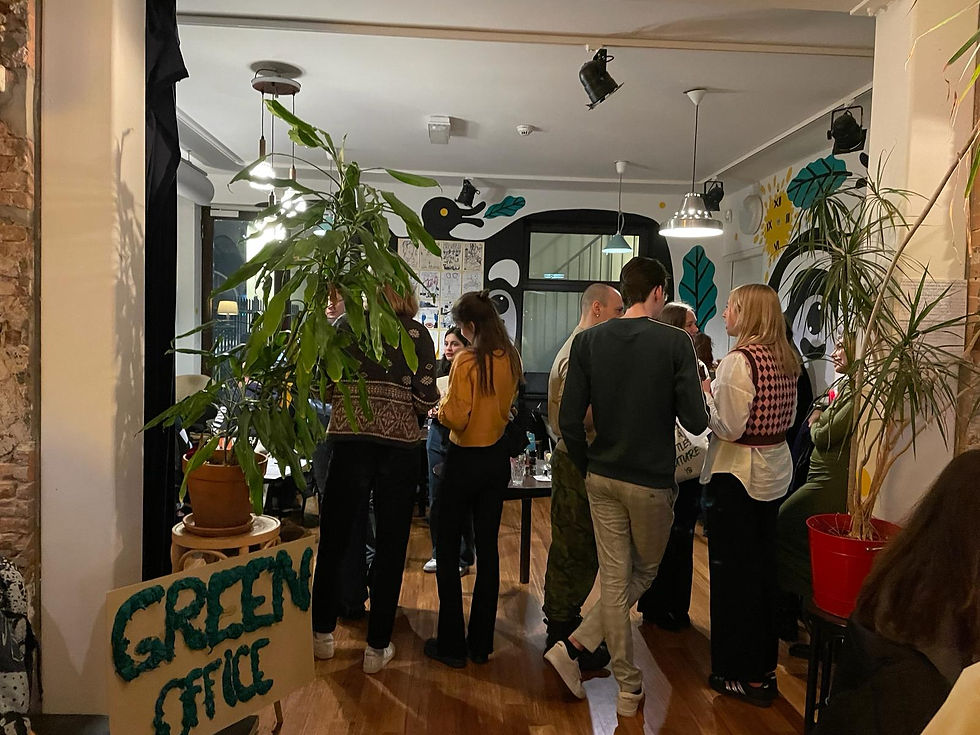Embracing Sustainability: Our Guide to a Greener Wardrobe
- Green Office

- Jun 9, 2024
- 3 min read
"Buy less, choose well, make it last." - V. Westwood
As defined by D’Aloia et al. (2017) fashion ‘is a wide set of performative practices characterized by a tension towards - or even obsession with - the new’. The world is obsessed with purchasing new clothes on a regular basis. This has ultimately made the fashion industry one of the most polluting industries in the world. This is further put into perspective through the UN Environment Programme which states, “the average person is buying 60 per cent more clothing than 15 years ago, while each item is kept for only half as long.”
Euromonitor International Apparel & Footwear 2016 Edition (volume sales trends 2005–2015); World Bank, World development indicators – GD (2017), Ellen MacArthur Foundation (2021)
With waste being so prominent in every stage of the garment manufacturing process, our mission is to mitigate and ultimately prevent this by embracing fashion ‘sustainably’. In doing so, we wish to encourage more productive and circular practices regarding clothing. Here are some ways to create your own eco-friendly wardrobe:
1.Go Thrifting
Thrifting is a great option if you want to be sustainable but still enjoy buying clothes. Amsterdam provides thrifting-enthusiasts with a multitude of lovely spots to explore. Not only does thrifting provide a unique shopping experience by yourself or with friends, but also allows you to simultaneously reduce waste and encourage circularity through the purchase of second-hand, or vintage items of clothing. In fact, we as the UvA Green Office have provided a map of our favorite thrifting locations in Amsterdam that can be found right inside our campus office.
De Lokatie, for example, is one of many stores you can find in Amsterdam that offer a great variety of vintage and second-hand items. For more information about De Lokatie, visit their website at https://www.delokatie.org/
Overwhelmed with the amount of choices you have for thrifting in Amsterdam? Well, first of all, how great is it that we live in a city with so many options? And, not to worry, we have a convenient way for you to always have a list of all second-hand stores at hand!
De Steek, an Amsterdam-based sewing cafe who we had the pleasure of hosting at our Sustainable Fashion Event in April, have created an easy to use list. Simply scan the QR code for an amazing resource! ->
More information on De Steek at https://desteekamsterdam.com/nl/
2. DIY and Upcycling
DIY (Do It Yourself) and upcycling practices are another great way to help contribute to sustainable fashion. Not only can upcycling help reduce textile waste by breathing life into old garments, but can also present an opportunity for a fun and creative side project. With an imaginative enough mind, items of clothing can be turned into anything from tote bags to headbands, quilts, or even lampshades. DIY practices involve a large degree of personal decision making and hence sustainable fashion in this sense can take the form of choosing natural and eco-friendly fabrics through which clothes are assembled, manipulated, and ultimately upcycled.
3. Clothing Swaps
Renting or swapping clothes are a great way to engage in fashion through acquiring new clothes without contributing to overconsumption. When you are not interested in keeping your clothes anymore, consider giving them a new life in someone else’s closet instead of throwing them away immediately. The UvA Green Office has a permanent clothing swap rack in the office, so do not hesitate to stop by at campus to drop your old clothes off and maybe take someone else’s clothes home with you. In addition to embracing sustainability, you may discover new pieces of clothing that you wouldn’t have otherwise considered, thereby reinventing or changing up your usual style.
4. Invest in timeless pieces
While thrifting is a great activity and solution, most people find it difficult to thrift 100% of the clothes in their closet. Instead of buying new clothes at fast fashion brands like Zara, H&M, etc. people can also invest in buying timeless clothing pieces from sustainable brands. Fast fashion brands have the urge to follow micro-trends when producing their clothing, which people like at that moment but after a few moments they get sick of it. Buying timeless pieces that you know you will love for a longer time will reduce the possibility of your clothes ending up in a landfill.
Sources:






